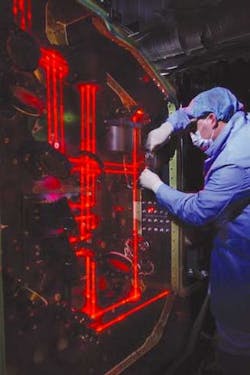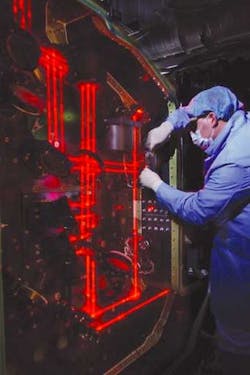Test moves missile-defense laser program closer to deployment
EDWARDS AIR FORCE BASE, Calif. -The future U.S. Airborne Laser system (ABL) took another step forward last month when modules of the system’s megawatt-class chemical oxygen-iodine laser were test fired for the first time while linked together as one unit.
Officials of the U.S. Missile Defense Agency test fired all six modules of the powerful laser on Nov. 10 at a special laser research facility at Edwards Air Force Base near Lancaster, Calif.
The chemical oxygen-iodine laser, better known as COIL, is to be mounted in the nose of a specially modified Boeing 747 jumbo jet. U.S. military leaders plan to use this future ABL system to shoot down ballistic missiles in their vulnerable boost phases.
The Nov. 10 test, which MDA officials called “First Light,” lasted les than a second. Experts fired laser light from the six modules into a wall of metal called a calorimeter, or beam dump. The temperature rise of the metal helped validate that the modules generated laser power.
After more tests are finished, experts will install the COIL on a flight test aircraft. Ultimately U.S. Department of Defense officials plan to conduct a realistic test as early as 2005 in which the ABL will shoot down a ballistic missile over the Pacific Ocean.
Boeing Integrated Defense Systems in St. Louis is responsible for the aircraft, Lockheed Martin Missiles and Space division in Sunnyvale, Calif., is building the turret and the optical system. The COIL modules come from the Northrop Grumman Space Technology division in Redondo Beach, Calif.
The ABL aircraft, meanwhile, is nearly ready for its first test flight in two years. Experts took the aircraft out of service in December 2002 for modifications to the airframe and to install the ABL’s laser beam control system. ABL integrators at first will test only the beam control system’s passive sensors.
Four lasers make up the ABL: the Active Ranger System (ARS); the Track Illuminator Laser (TILL); the Beacon Illuminator Laser (BILL); and the COIL.
The TILL and BILL will be fitted to the aircraft early next year so experts can test the full beam-control system in flight. The carbon dioxide ARS, which propagates at a wavelength of 11.15 microns, bounces a beam off a target to produce high-resolution tracking data.
The TILL Yb:YAG solid-state laser produces a pulsed 1.03-micron beam that helps stabilize cameras that track the missile. The BILL, a pulsed Nd:YAG laser bounces a beam off the target to help optical equipment and software compensate for atmospheric distortion.
The COIL, which actually destroys the target, is a 1.5-meter-diameter laser that heats the skin of the missile enough to cause it to explode. It is a continuous-wave laser that propagates at 1.315 microns, a wavelength that travels well through the atmosphere.
The ABL program reportedly has gone through a two-year delay after systems integrators were not able to develop a laser that would fit in the nose of its 747 aircraft. Pentagon officials reportedly say the laser system developed in 2002 was too heavy for flight.
